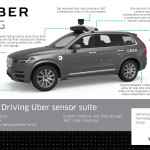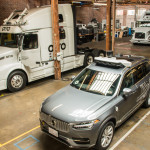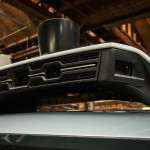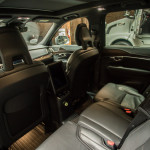
WHY THIS MATTERS IN BRIEF
while many questions remain about the safety of self-driving cars companies like Uber continue to push the boundaries of both technology and regulations, this is their second self-driving car pilot and their technology has already come on leaps and bounds.
Already being trialled in Pittsburgh Uber’s self-driving cars are now on the move to San Francisco, in a new expansion of its pilot project with autonomous vehicles that will see Volvo XC90 SUVs outfitted with sensors and supercomputers begin picking up passengers in the city.
The autonomous cars won’t operate completely driverless, for the time being as they do in Pittsburgh, and for the moment each SUV will have a safety driver and Uber test engineer onboard to handle manual driving when needed and monitor progress with the tests. But the cars will still be picking up ordinary passengers – any customers who request UberX using the standard consumer facing mobile app are eligible for a ride in one of the new XC90s operated by Uber’s Advanced Technologies Group (ATG).
There’s a difference here beyond the geography though, this is the third generation of Uber’s autonomous vehicle, which is distinct from the second generation Fords that were used in the Pittsburgh pilot. Uber has a more direct relationship with Volvo in turning its new XC90s into cars with autonomous capabilities, the Fords were essentially purchased stock off the line, while Uber’s partnership with Volvo means it can do more in terms of integrating its own sensor array into the ones available on board the vehicle already.
Uber ATG Head of Product Matt Sweeney said in an interview that this third generation vehicle actually uses fewer sensors than the Fords that are on the roads in Pittsburgh, though the loadout still includes a full complement of traditional optical cameras, radar, LiDAR and ultrasonic detectors. He said that fewer sensors are required in part because of the lessons learned from the Pittsburgh rollout, and from their work studying previous generation vehicles; with autonomy, you typically start by throwing everything you can think of at the problem, and then you narrow based on what’s specifically useful, and what turns out not to be so necessary. Still, the fused image of the world that results from data gathered from the Volvo’s sensor suite does not lack for detail.
“You combine [images and LiDAR] together you end up with an image which you know very explicitly distance information about, so it’s like this beautiful object that you can detect as you’re moving through,” said Sweeney, “and with some of the better engineered integration here, we have some radars in the front and rear bumpers behind the facades.”
Those radar arrays provide more than just the ability to see even in conditions it might be difficult to do so optically, as in poor weather; Sweeney notes that the radar units they’re using can actually bounce signal off the surface of the road, underneath or around vehicles in front, in order to look for and report back information on potential accidents or hazards not immediately in front of the autonomous Uber itself.
Many people have asked why, out of all of the cars and car manufacturers uber could have chosen for their road tests, they chose Volvo.
“The car is one of the reasons we’re really excited about this partnership, it’s a really tremendous vehicle,” Sweeney said, “it’s Volvo’s new SPA, the Scalable Platform Architecture – the first car on their brand new, built from the ground up vehicle architecture, so you get all new mechanical, all new electrical, all new compute.”
Uber didn’t pick a partner blindly – Sweeney says they found a company with a reputation for nearly a hundred years of solid engineering, manufacturing and a commitment to iterating improvement in those areas.
“The vehicle that we’re building on top of, we’re very intentional about it,” Sweeney said, noting that cars like this one are engineered specifically for safety, which is not the main failure point when it comes to most automobile accidents today – that role is reserved for the human drivers behind the wheel.
Uber’s contributions are mainly in the sensor pod and in the compute stack in the trunk which takes up about half the storage space and which Sweeney said is “a blade architecture, a whole bunch of CPUs and GPUs that we can swap out under there,” and while he wouldn’t say who’s supplying those components there are only a few manufacturers in the space so it’s likely to be one of the common tech giants with a sprinkling of GPU’s from Nvidia. The tremendous computing power it represents though is arguably the key that makes the entire solution work – whether that’s helping to identify more objects more accurately or helping improve the routing in dynamic, complex city street environments.
Uber’s pilot in San Francisco will initially be limited to the downtown area to start, and will involve “a handful” of vehicles, with the intent of ramping up from there according to the company. The autonomous vehicles in Pittsburgh will also continue to run concurrently with the San Francisco deployment. Where Pittsburgh offers a range of weather conditions and other environmental variables for testing, San Francisco will provide new challenges for Uber’s self-driving tech, including denser, often more chaotic traffic, plus narrower lanes and roads.
The company doesn’t require a permit from the California DMV to operate in the state, it says, because the cars don’t qualify as fully autonomous as defined by state law because of the always present onboard safety operator. Legally, it’s more akin to a Tesla with Autopilot than to a self-driving Waymo car, under current regulatory rules, says Uber – although we’d expect the local DMV to have something to say about that.
Ultimately, the goal for Uber in autonomy is to create safer roads, according to Sweeney, while at the same time improving urban planning and space problems stemming from a vehicle ownership model that sees most cars sitting idle and unused somewhere near 95 percent of the time. I asked Sweeney about concerns from drivers and members of the public who can be very vocal about autonomous tech’s safety on real roads.
“This car has got centimeter level distance measurements 360-degrees around the vehicle constantly, 20 meters front and 20 meters back constantly,” Sweeney said, noting that even though the autonomous decision making remains “a really big challenge,” the advances achieved by the sensors themselves and “their continuous attention and superhuman perception […] sets us up for the first really marked decrease in automotive fatalities since the airbag.”
“I think this is where we really push it down to zero,” he added, “people treat it as though it’s a fact of life; it’s only because we’re used to it. We can do way better than this.”





















[…] began testing a fleet of 16 self driving Volvo SUVs in San Francisco earlier this month. A week later, California’s Department of Motor Vehicles (DMV) revoked all 16 registrations, […]
[…] regulators have kept humans in the driver’s seat in Uber’s self-driving cars in Pittsburgh and San Francisco and it’s likely that the regulators will still require certified commercial vehicle operators […]
[…] Michigan, new regulations, hundreds of trials, and new fleets being rolled out in Pittsburgh, San Franciso and Singapore, to name but a few. Everything has to start somewhere – plus, the fact that […]
[…] self-driving car, as well as self-driving truck trials, have already taken place in Michigan, San Francisco and […]